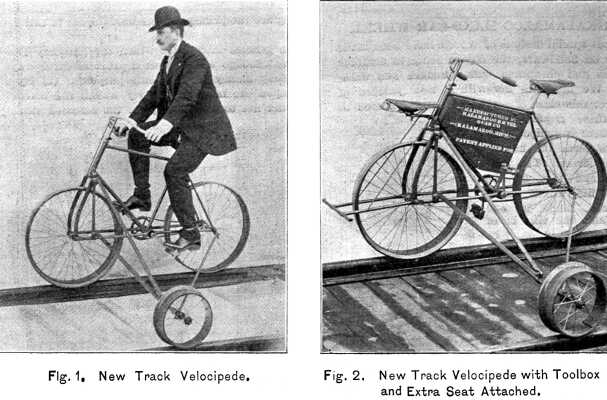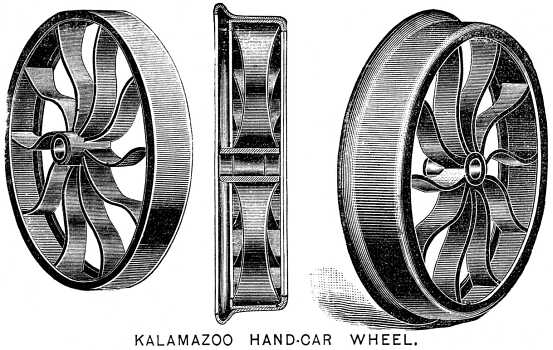|
A NEW RAILWAY VELOCIPEDE.
Engineering News—February, 1895
The railway velocipede shown in the accompanying illustration
is an adaptation of the design of the safety bicycle to track
service, the machine having a, flanged tire on the front wheel
and a blind tire on the rear wheel, and being held upright by
a  brace carrying
a small guide wheel, with flanged tire running on the opposite
rail. The larger wheels are 24 ins. diameter, with 32 tangent
spokes of No. 12 wire, and the rims are of No. 16 steel, with
an outward bead on the outer edge and an inward bead at the middle,
to increase the stiffness. The small wheel is 11 ins. diameter,
and is journaled on the end of a pivoted arm, which, by unhooking
the end of the brace rod from the back of the frame, may be swung
back against the frame for shipment in a baggage car, or on the
platform of a passenger car. The space occupied, when thus folded,
is only 6 ft. x 1 ft. 6 ins., a little more than that required
for a road bicycle. The flanges of the front wheel and guide wheel
are made of the M. C. B. standard outline, and the flat tire of
the rear wheel is wide enough to eliminate all danger of slipping
off the rail. The frame holds the, two wheels rigidly in line,
but the rider can guide the front wheel on curves and at frogs
and switches, and so secure easy riding with less wear on the
flanges and less liability to derailment at worn switches and
frogs than where the flanges are relied upon to do all the guiding,
as in the ordinary style of track velocipede. The wheels have
rubber bands 3 ins. wide and 3-16 in. thick on the tread, which
make the machine run easily without jar, and also without noise,
so that the rider can catch the sound of approaching trains, while
they also make the machine run more safely at high speed when
the rails are wet or frosty. The hubs have ball bearings of the
latest dust-proof pattern, and the bearings, cranks and pedals,
driving chain and gearing, saddle, handle bars and other parts
are of standard patterns as used on road bicycles, so that repairs
and renewals can be readily made at bicycle stores. The frame
is of No. 16 Shelby seamless steel tubing, with drop-forged connections
thoroughly brazed. brace carrying
a small guide wheel, with flanged tire running on the opposite
rail. The larger wheels are 24 ins. diameter, with 32 tangent
spokes of No. 12 wire, and the rims are of No. 16 steel, with
an outward bead on the outer edge and an inward bead at the middle,
to increase the stiffness. The small wheel is 11 ins. diameter,
and is journaled on the end of a pivoted arm, which, by unhooking
the end of the brace rod from the back of the frame, may be swung
back against the frame for shipment in a baggage car, or on the
platform of a passenger car. The space occupied, when thus folded,
is only 6 ft. x 1 ft. 6 ins., a little more than that required
for a road bicycle. The flanges of the front wheel and guide wheel
are made of the M. C. B. standard outline, and the flat tire of
the rear wheel is wide enough to eliminate all danger of slipping
off the rail. The frame holds the, two wheels rigidly in line,
but the rider can guide the front wheel on curves and at frogs
and switches, and so secure easy riding with less wear on the
flanges and less liability to derailment at worn switches and
frogs than where the flanges are relied upon to do all the guiding,
as in the ordinary style of track velocipede. The wheels have
rubber bands 3 ins. wide and 3-16 in. thick on the tread, which
make the machine run easily without jar, and also without noise,
so that the rider can catch the sound of approaching trains, while
they also make the machine run more safely at high speed when
the rails are wet or frosty. The hubs have ball bearings of the
latest dust-proof pattern, and the bearings, cranks and pedals,
driving chain and gearing, saddle, handle bars and other parts
are of standard patterns as used on road bicycles, so that repairs
and renewals can be readily made at bicycle stores. The frame
is of No. 16 Shelby seamless steel tubing, with drop-forged connections
thoroughly brazed.
A toolbox can be hung from the top horizontal bar of the frame,
and a front seat and footrest can be attached to the front vertical
bar for carrying a second rider. The weight of the machine is
55 lbs., or 60 lbs. with the second seat attached. This velocipede
was designed by Mr. G. W. Miller, of the Kalamazoo Railroad Velocipede
& Car Co., and is being manufactured by that company. It is
interesting to note that a similar application of the old-fashioned
bicycle, with one high wheel and one small rear wheel, was tried
some time ago on the Transcaspian Railway, of Russia, the wheels
having grooved tires and the machine being supported by an arm
carrying a guide wheel running on the opposite rail.
THE, KALAMAZOO HAND-CAR WHEEL.
Engineering News—February, 1895
 Various special
designs of wheels have been made for use on hand-cars, the object
being to combine lightness and cheapness with strength and durability.
We illustrate herewith a new pattern of wheel for this class of
service, which is claimed to meet these requirements. The wheel
is composed of but two parts and has no bolts or rivets. The hub,
spokes and rim of the wheel center are of malleable iron, made
in one piece, and the rim is of channel section, in order to increase
its stiffness. The tire is of steel, without a weld, being made
from a solid blank, and is shrunk upon the wheel center, the rim
of which reinforces the tread. The spokes are curved; so that
a certain amount of spring is secured in the wheel itself. The
rim is turned to fit a 20-in. tire and may be applied in repairs
to the tires of old wheels whose centers have worn out. This wheel
is being introduced by the Kalamazoo Railroad Velocipede &
Car Co., of Kalamazoo, Mich., and has been protected by patents.
It will be used on all this Company's hand and push cars, instead
of the plate center wheel illustrated in our issue of May 12,
1892, and we are informed that several hundred wheels of this
new pattern are now in service and have proved very satisfactory
to the railways using them. Various special
designs of wheels have been made for use on hand-cars, the object
being to combine lightness and cheapness with strength and durability.
We illustrate herewith a new pattern of wheel for this class of
service, which is claimed to meet these requirements. The wheel
is composed of but two parts and has no bolts or rivets. The hub,
spokes and rim of the wheel center are of malleable iron, made
in one piece, and the rim is of channel section, in order to increase
its stiffness. The tire is of steel, without a weld, being made
from a solid blank, and is shrunk upon the wheel center, the rim
of which reinforces the tread. The spokes are curved; so that
a certain amount of spring is secured in the wheel itself. The
rim is turned to fit a 20-in. tire and may be applied in repairs
to the tires of old wheels whose centers have worn out. This wheel
is being introduced by the Kalamazoo Railroad Velocipede &
Car Co., of Kalamazoo, Mich., and has been protected by patents.
It will be used on all this Company's hand and push cars, instead
of the plate center wheel illustrated in our issue of May 12,
1892, and we are informed that several hundred wheels of this
new pattern are now in service and have proved very satisfactory
to the railways using them.
Oddities
| Contents Page
|







